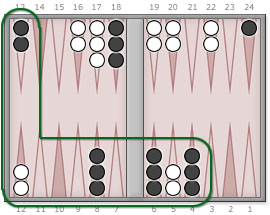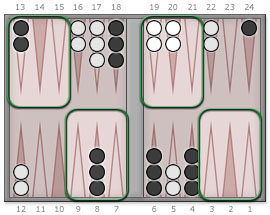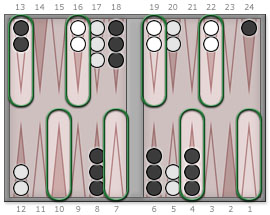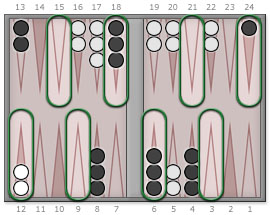|
| Pip Counting |

Colorless Counting
For some cube decisions, the exact pip count is essential. However for most positions, the pip-count difference is all that is needed. Many players don’t realize that knowing the pip difference is not just helpful in racing games, but also in back games, priming games, and contact positions where timing is key. Most of us don’t bother to count pips as often as we should because it’s laborious and time consuming. Urquhart colorless counting solves that problem.
When Robert Urquhart first described his approach to Phil Simborg, his backgammon teacher, Phil found it confusing, and we agreed that together we could come up with an article that explains both the concept and application in a manner that even people with Phil’s low I.Q. could understand.
The process may sound complicated at first, but it really is not difficult to learn and use with some practice. The computation can be done quickly and you never have to use or remember large numbers.
The first, and most amazing, aspect of this approach is that you ignore the colors of the checkers. It doesn’t matter whether a checker you count is one of yours or his, therefore it is “colorless.” With this in mind, here are the steps:
- Crossovers
- Semi-crossovers
- Unit crossovers
Let’s calculate these for a sample position:
|
|
Position 1 |
Step 1: Crossovers
A crossover is the number of 6’s it takes to move a checker into its inner board. Each quadrant of the board has 6 points, therefore each crossover is worth 6 pips. Traditional methods of counting crossovers require counting the number of crossovers for all 30 checkers, but UCC employs a shortcut using the “colorless” method.
Find the fifteenth checker, regardless of color, starting from black’s bearoff tray. In this case, the fifteenth checker is the second, also last, checker on black’s 13 point.

| Imagine these as black’s fifteen checkers. |
Now count crossovers for these checkers. You should get a total of 9: 2 × 2, for the two checkers on the 13 point, plus 5 for the five checkers in black’s outer board.
The other 15 checkers are considered to be white’s checkers. White has 8 colorless crossovers — the 8 remaining checkers in white’s outer board after excluding the two on the 13 point already counted.
White has 8 and black has 9. Since black has one more crossover he is behind in the race by 6 pips.
Step 2: Semi-Crossovers
Each quadrant has two halves consisting of three consecutive points, or triads. One triad is nearer to black’s bearoff tray (the near triad), and the other farther from black’s bearoff tray (the far triad). On black’s side of the board, the near triads consist of points 1, 2, and 3, and points 7, 8, and 9. On the other side, the near triads consist of points 13, 14, and 15 and points 19, 20, and 21.

| The four near triads. |
Count the number of checkers (of any color) in all four near triads. Fifteen semi-crossovers is the breakeven point — fewer than 15 means you’re losing in the race, more than 15 means you’re gaining in the race. Each semi-crossover is worth 3 pips.
In Position 1, the total number of checkers on the near triads is 9. Thus black has a deficit of 6 semi-crossovers, which is a loss in the race of 18 pips (6 × 3). Added to his 6 pip disadvantage from crossovers, black has a net disadvantage of 24 pips so far.
Step 3: Unit Crossovers
Within each triad, there is a nearer point and a farther point relative to black’s bearoff tray. For example, in black’s inner board the 1 and 4 are near points, and the 3 and 6 are far points.
 Near points. |
 Far points. |
Unit crossovers equal the total number of near-point checkers minus the total number of far-point checkers. The center points in each triad are neutral.
For example, if you look at the 16-17-18 triad, black has three checkers on the 18 point, a far-point, costing black 3 pips in the race, and two checkers on the 16 point, a near point, gaining black 2 pips in the race. The 17 point is not relevant. The net for this triad is a loss of 1 pip (one more far-point checkers than near-point checkers).
Repeating this process for the other 7 triads in Position 1, black nets a 2-pip advantage in the race relative to unit crossovers.
Summary
In Step 1 (crossovers), black lost 6 pips. In Step 2 (semi-crossovers), black lost 18 pips and in Step 3 (unit crossovers) black gained 2 pips. Black is 22 pips behind.
The actual pip count for Position 1 is white 136 and black 158, showing that black is 22 pips behind. Extreme Gammon expresses this as +22 pips. (The ”+” means you have more pips and are losing the race.)
Tips
Okay, we hear you — this sounds complicated. Why not just count the entire race using cluster counting or some other shortcut? Well, if you are one of the few people in the world who can count the actual numbers quickly and accurately you don’t need UCC. But for most of us, UCC is far easier and faster and far less mentally taxing. As a result you will count more often and, bottom line, this will make you a better player.
Here are some tips to help you use UCC:
- Remember that checker color does not matter.
- The three steps can be done in any order. Do whichever order you find most natural.
- After each step, you can easily keep the running total on your fingers.
- For step 2 (semi-crossovers) and step 3 (unit crossovers), the order that you accumulate the counts is immaterial. We like to start at the 24 point, in both cases.
- Make up your own shortcuts as you go. Steps 1 and 3 lend themselves to pattern recognition short cuts.
- Practice makes perfect. You will get confused the first few times you do this, but it’s really not hard.
A Second Example
|
|
Position 2 A back game. |
Position 2 shows a 2-3 back game. Is it well timed? Should you run or hit? Most of these decisions in a back game depend on timing. Phil teaches that a 2-3 back game needs about 90–100 or more pips to be well timed. Let’s use UCC to find out where we stand.
Step 1: Colorless crossovers.
The fifteenth checker from black’s bearoff tray is the first checker on the 9 point. Black has 3 colorless crossovers — 2 chceckers on the 8 point and 1 on the 9 point (the other checker is white’s).
White has 13 crossovers - 8 for the remaining 4 checkers in black’s outer board (4 × 2), plus 5 for the checkers in his outer court. Black has 10 fewer crossovers, thus has a 60 (6 × 10) pip lead. Notice, after identifying the fifteenth checker, with a little practice, you can get the crossover difference almost immediately.
We leave it as an exercise for the reader to do a normal crossover count here. It better give the same answer. Try it and see. If it isn’t equal it shows one big advantage of colorless crossovers, namely, they are less error prone.
Another benefit is the amount of mental energy required. For normal crossovers you often need to examine all 4 boards, sometimes more than once. Then you apply a variable weight (1 to 3 crossovers for each checker), add up all the pieces, and finally take the difference.
Step 2: Semi-crossovers
Count all the checkers in the near triad of each quadrant. For Position 2 that number is 18 (5 + 3 + 4 + 6). That was really easy! Since 15 is the breakeven point, step 2 gives black an additional 9 point pip lead (3 × (18 − 15)). Now black is ahead by 69 pips.
(By the way, it can be shown that counting only crossovers can result errors of ±10 pips (1 standard deviation = 9.1). By adding this simple step, the easiest of the 3 steps, you cut the standard deviation to 4.5 pips. That is a pretty big bang for the buck.)
Step 3: Unit crossovers
Count the number of near-point checkers minus the number of far-point checkers for all 8 triads. Starting at the 22-23-24 triad, the eight numbers are: −1, 3, 0, 3, −2, −2, 0, −3 = −2. Did you follow that? Once you get the hang of it, just keep a running sum.
So black has 2 more far-point checkers than near-point checkers, costing him 2 pips in the race. Black was ahead by 69 pips. He lost 2 pips in step 3, so he ends up being 67 pips ahead in the race. Not a very well timed back game for white. White will probably want to get hit and black generally wants to avoid hitting.
A Third Example
|
|
Position 3 Black is desperately hanging on. |
We’ll count this time with minimum comments to give you an idea of how fast it can get. Want to try it yourself first?
Step 1: Colorless crossovers.
Fifteenth checker is the second checker on the 13 point. Black has 5 (8 − 3) more crossovers than white, therefore black is 30 pips down.
Step 2: Semi-crossovers.
Count total checkers in near triads: 9 + 3 + 3 + 1 = 16. Black has 1 extra semi-crossover thus gains 3 pips in the race. Black now trails by 27 pips.
Step 3: Unit crossovers.
The running sum, by triads, near-points minus far-points is: 0, 0, 0, 3, 2, 5, −1, 0. So this doesn’t change the race and black finishes 27 pips down.
XG shows white’s pip count at 139 and black’s pip count at 166. The difference is 27.
Easy right? How easy was riding a bicycle the first time? With a little practice, this is just as easy.
Checkers on the Bar or Borne Off
You might be wondering, does this work for men on the bar and checkers that have been borne off.
The technical answer is yes. The practical answer is it’s doubtful there are many situations where you need an exact difference count when there are checkers on the bar. Likewise if you are in the bear-off phase you probably need to be using a racing formula to properly take care of distribution, wastage etc.
However the method does work if you are so inclined to use it here.
For black’s side, due to the colorless invariance, a white checker on the bar and a black checker that have borne off are equivalent. First of all, include these checkers in your step 1 count to 15. Each such checker results in a 5 pip gain in the race (roughly worth an extra crossover).
For white’s side it is simpler. Each black checker on white’s bar or white checker that has borne off costs you 2 pips in the race.
As to the why, and where did this algorithm come from, and how it can be proven, that’s for another time and place. However for the scientifically inclined we can say that its father was an “invariant” and the offspring is “orthogonal”.
An absolute (rather than relative) pip counting algorithm using the nearly the same steps has also been developed.
